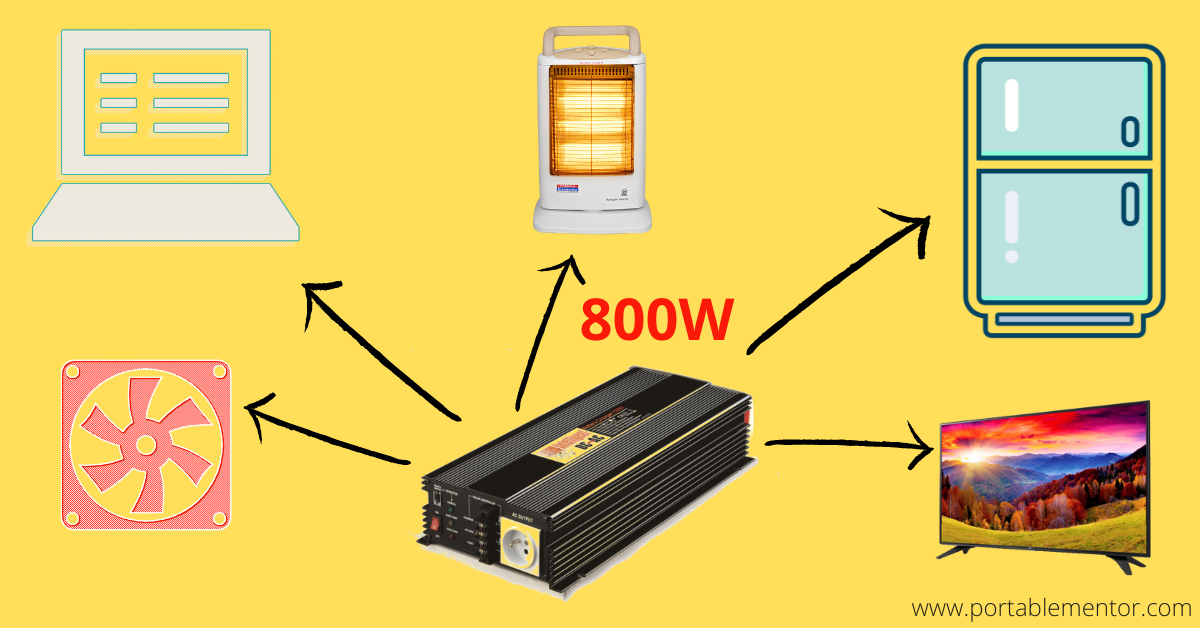
In this article, we will explore the capabilities of an 800-watt inverter, understanding what it can power with some examples.
Understanding the 800-Watt Inverter
An 800-watt inverter is a versatile device that transforms direct current (DC) from a battery into alternating current (AC). This AC power can then be used to run various appliances.
The "800-watt" part signifies that this inverter can supply up to 800 watts of continuous AC power.
While it's worth mentioning that some power loss occurs during the conversion process, this is a normal part of the operation and is accounted for in the design of the inverter. Most inverters today operate at around 90% efficiency.
This means that to power a 200-watt AC appliance, an 800-watt inverter would draw approximately 220 DC watts from the battery.
Consequently, when operating at full capacity with a 90% efficiency rate, an 800-watt inverter will draw around 880 DC watts from the battery.
The Concept of Surge Wattage
Surge wattage is the initial power boost required to start an appliance. Devices like refrigerators and other motor-based appliances typically require this surge wattage.
An 800-watt inverter usually has a surge wattage of around 1600 watts.
What Can A 800-watt Inverter Run?
An 800-watt inverter can power a diverse range of appliances, as long as their total power consumption doesn't exceed 800 watts.
Here are a few examples of what an 800-watt inverter can run:
- Computer (300W)
- Laptop (60W)
- Ceiling Fan (90W)
- Coffee maker (800W)
- Electric blanket (200W)
- Fridge (100W)
- Laser printer
- Microwave (600-1200W)
As you can see, an 800-watt inverter can comfortably run a computer, laptop, ceiling fan, electric blanket, fridge, and a small microwave.
Keep in mind, for optimal performance and safety, it's best to ensure that the total wattage of all appliances is within the capacity of the inverter.
For instance, an 800-watt inverter can simultaneously run eight 100-watt appliances. Although it is advisable to leave 20% room for safety factors.
To find out 'how long your 800-watt can power appliances' use our battery life calculator.
Video - Testing Pure sine wave VS Modified sine wave inverter
Can An 800w Inverter Run A Fridge?
Modern refrigerators typically consume around 100 watts of AC power. However, they require a surge wattage of about 400 watts to start, which an 800-watt inverter can easily handle.
Therefore, an 800-watt inverter can indeed power a fridge, with the duration depending on the size of the battery.
Will An 800 Watt Inverter Run A Microwave?
Microwaves consume between 600 and 1200 watts of AC power, depending on their size. Therefore, an 800-watt inverter can power a small microwave that consumes 600 watts.
For larger microwaves that consume more than 800 watts, upgrading to a more powerful inverter will provide the necessary support.
how many amps does 800 watt inverter draws from the battery?
The formula to calculate the amps an inverter will draw from the battery:
Output AC load in Watts ÷ Battery volts.
Therefore, if you're running your 800-watt inverter at full capacity, it will draw approximately 66.6 amps from a 12v battery and 33.3 amps from a 24v battery system.
In simple terms:
- From a 12v battery: An 800-watt inverter will draw 66.6 amps when running at full capacity.
- From a 24v battery: An 800-watt inverter will draw 33.3 amps when running at full capacity.
How many batteries for 800 watt inverter?
For an 800-watt inverter, you generally need about two 12v 200ah lithium batteries to run at its full capacity for 5 hours.
The number of batteries required for an 800 watt inverter depends on the total power consumption and the desired running time. To calculate the number of batteries needed, follow these steps:
- Start by calculating the total power consumption of your appliances.
- Decide on the desired running time.
Use this formula:
Battery size required = Total load × Desired running hours × 1.1 ÷ System voltage × 1.65 (for lead acid battery) or × by 1.02 for lithium battery)
Alternatively, you can use our calculator to determine the battery size for an 800-watt inverter.
Tips for running an inverter
Here are some helpful guidelines for utilizing an 800-watt inverter to power your devices:
- Use the right size wiring for your inverter: For an 800-watt inverter using a 12v battery, 2 AWG wire size is recommended. For a 24v battery, a 4 AWG wire size is recommended.
- Choose the Right Battery: The battery is the backbone of your inverter system. Choose a high-quality battery with a suitable capacity. Deep cycle batteries are often recommended for inverters.
- Proper Ventilation: Ensure your inverter and battery are placed in a well-ventilated area. With proper ventilation, you can prevent batteries from emitting gases and keep inverters from overheating, ensuring a safe and efficient operation.
- Maintain Balance: By connecting just the right number of appliances or devices to your inverter, you can ensure its optimal performance and longevity.
- Monitor Battery Health: Regularly checking your battery's health helps maintain its performance. If you observe that the battery isn't holding a charge as efficiently as it used to, this could be the perfect time to consider enhancing your setup with a new, more efficient battery.
I hope this guide was helpful to you, have any queries Contact US thank you!



